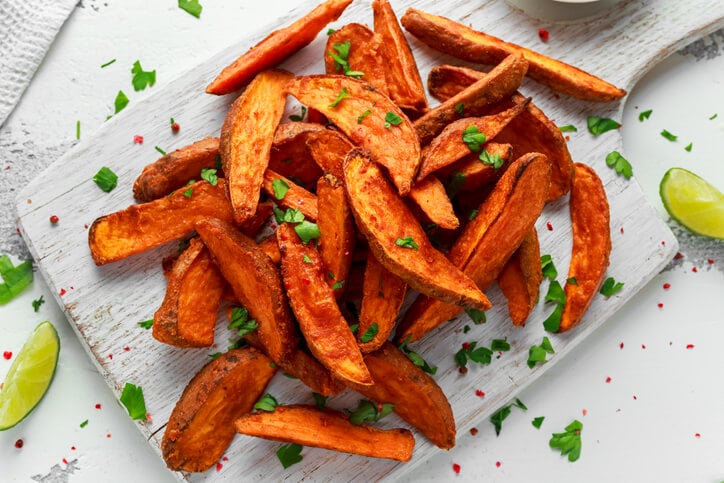Sweet potatoes are starchy – and as you may have guessed, sweet – root vegetables. Most of us are familiar with the ones that have a brown skin and orange insides, but you can find ones with skin colors that range from white to yellow, red, and purple too – with white to yellow, orange, or orange-red flesh.
What’s the difference between sweet potatoes and yams?
According to the Library of Congress, sweet potatoes are classified as either ‘firm’ or ‘soft’. When cooked, those in the ‘firm’ category remain firm, while ‘soft’ varieties become soft and moist. It is the ‘soft’ varieties that are often labeled as yams in the United States.
But yams and sweet potatoes are two different species. Yams are closely related to lilies and grasses; sweet potatoes are members of the morning glory family. Compared to sweet potatoes, yams are starchier and drier.
Which is healthier – yams or sweet potatoes?
Both have nutritional benefits, but overall sweet potatoes are more nutritious than yams – with higher concentrations of most nutrients and more fiber. Here are the basic stats:
One cup of baked sweet potato with skin provides:
- Calories: 180
- Carbs: 41.4 grams
- Protein: 4 grams
- Fat: 0.3 grams
- Fiber: 6.6 grams
- Vitamin A: 769% of the
- Daily Value (DV)
- Vitamin C: 65% of the DV
- Manganese: 50% of the DV
- Vitamin B6: 29% of the DV
- Potassium: 27% of the DV
- Pantothenic acid: 18% of the DV
- Copper: 16% of the DV
- Niacin: 15% of the DV
Sweet potatoes — particularly the orange and purple varieties — are rich in antioxidants that protect your body from free radicals.
Wait, what are free radicals?
A free radical is a single atom with unpaired electrons. Electrons prefer to be part of a pair, and free radicals forage through the body, looking for an electron so it can pair. This hunt can damage cells, proteins and DNA and has been linked to inflammation in the body, cancer, atherosclerosis, Alzheimer’s disease, Parkinson’s disease and other conditions, as well as the overall process of aging. Antioxidants like sweet potatoes can reduce or contain the damage that can be caused by free radicals
Antioxidants and your body
The fiber and antioxidants in sweet potatoes also support gut health, promoting the growth of good bacteria, keeping your digestive system functioning well, and adding bulk without a lot of calories.
Orange-fleshed sweet potatoes are also a great source of beta-carotene, an antioxidant that is converted to vitamin A in your body. It supports your vision, and is believed to be healing to eyes over-exposed to blue light (which is most of us, in our world full of screens). Vitamin A is also critical to a health immune system.
Purple sweet potatoes also seem to have vision benefits, and may also support brain function thanks to the anthocyanins (another type of antioxidant). The jury is still out on this, but early studies look promising.
Sweet potatoes and oral health
Foods that are anti-inflammatory and support a healthy immune system are great for your oral health. That vitamin A in sweet potatoes also helps to keep the soft tissue of the gums healthy, and maintains keratin, a protein that promotes formation of tooth enamel – studies are indicating that keratin may provide ways to ward off dental decay, but eating sweet potatoes can’t rebuild enamel – nothing can. Keratin may help strengthen enamel. And sweet potatoes can also help build bone mineral density, thanks to the potassium that they contain. So include them in your healthy holiday feast – and as part of your everyday diet too. But keep the add-ons to a minimum – that traditional marshmallow-sweet-potato casserole doesn’t support dental health. Have a bit if you like, but rinse your mouth with plain, warm water right afterwards to remove the sugar from your teeth.
It’s important to note that even the healthiest food choices will keep teeth healthy if you don’t have a good oral health routine, which includes regular dental checkups and cleanings. If regular dental care doesn’t fit into your budget, you can get healthy with a dental savings plan.
A dental savings plan cuts dental costs by 10%-60%. And unlike traditional dental insurance, there is no waiting period for costlier procedures, and no restrictions on getting treatment for pre-existing conditions. Learn more about dental savings plans today!
